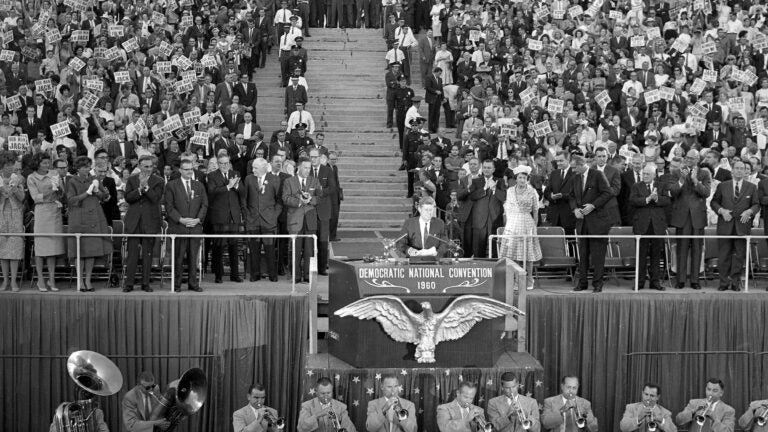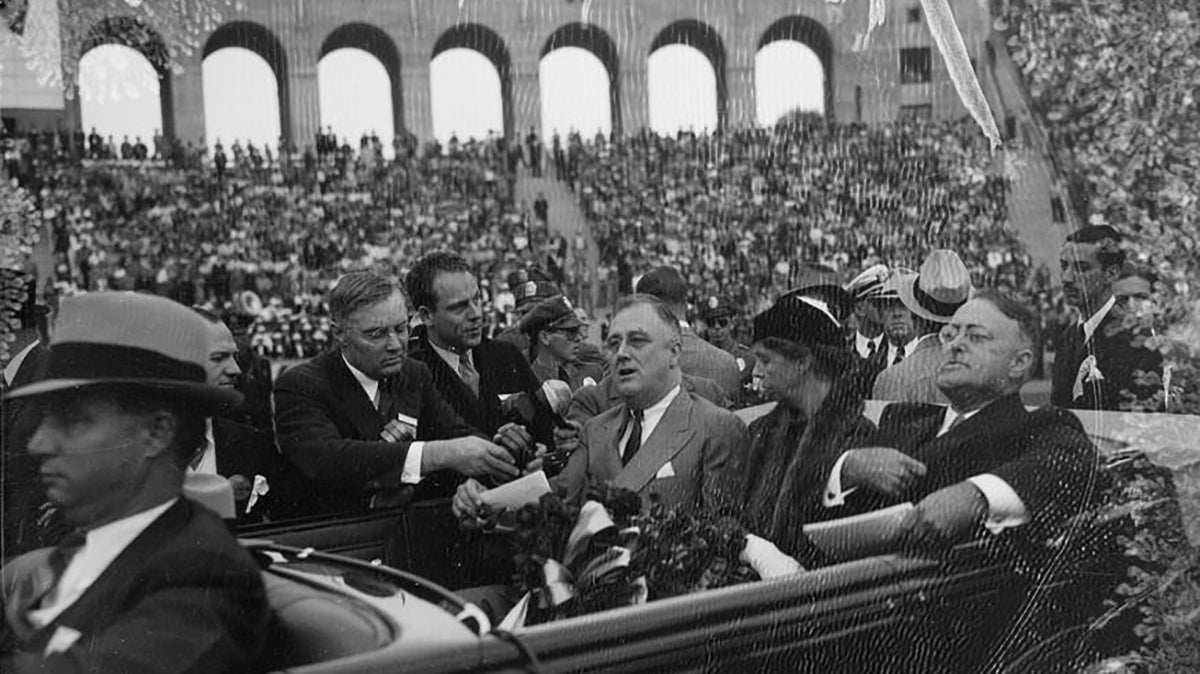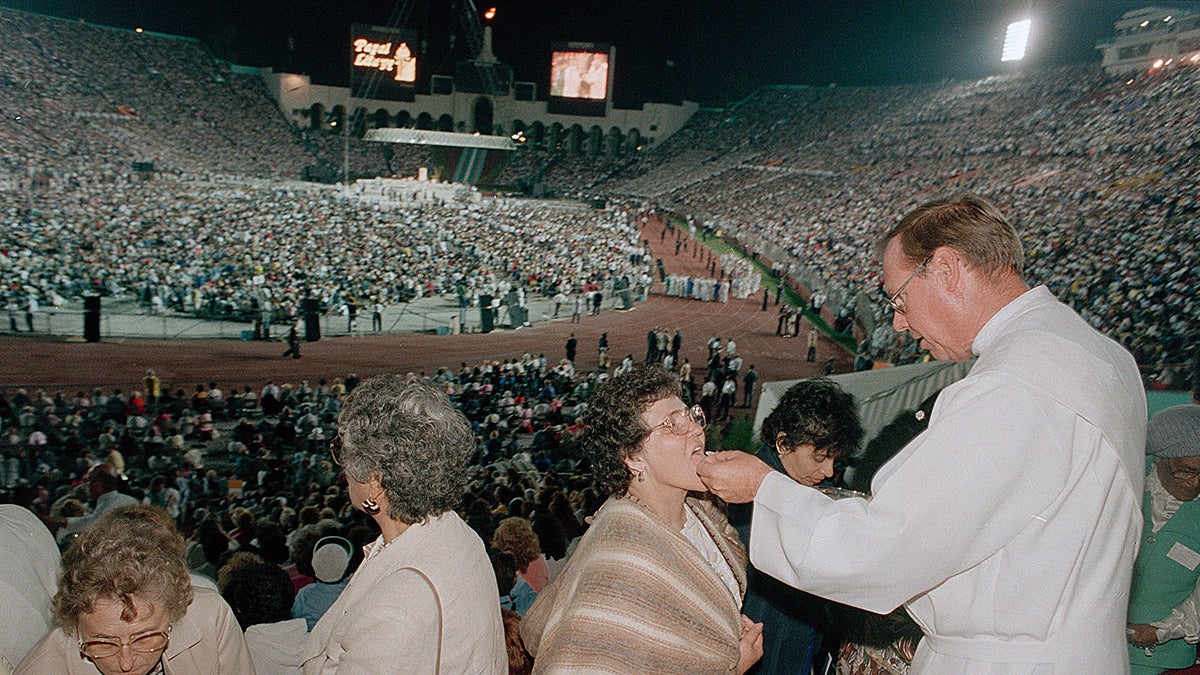
In this July 15, 1960 photo, Sen. John F. Kennedy accepts the Democratic party’s nomination for president at the Los Angeles Memorial Coliseum. (AP Photo/File)
Music and culture at the Los Angeles Memorial Coliseum
For more than 100 years, the Los Angeles Memorial Coliseum has kept a finger on the pulse of music, politics, religion and culture. Where else could you see both a pope and a pop star?
On a sweltering August day in 1972, more than 100,000 people gathered at the Los Angeles Memorial Coliseum for a concert. Soul record label Stax Records organized this installment of the Watts Summer Festival to benefit local South Los Angeles communities recovering from the civil unrest in Watts seven years earlier and grappling with the ongoing struggle for racial equality.
Dubbed “Wattstax,” it featured rousing sets from Isaac Hayes, the Staple Singers, Rufus Thomas, the Soul Children and other soul, gospel, rhythm and blues, and jazz acts. Baptist minister and civil rights activist Jesse Jackson, who served as emcee, gave a riveting speech celebrating African American pride to the sold-out crowd. Widely regarded as a day of healing and unity for the Black community, it was a historic event and was also known as the “Black Woodstock.”
The event captured the essence of the Coliseum’s cultural history: Music and pop culture colliding with politics and religion. Community interests illuminating themes of national significance.
Though the 100-year-old stadium is best known for its athletic distinctions — among them hosting two Olympic Games (soon to be three in 2028) and being home to USC Trojans football since 1923 — its legacy rests on so much more than sports.
A pope, six U.S. presidents, international dignitaries, the biggest names in rock and soul: A veritable who’s who of the past century’s cultural luminaries have come to the Coliseum to amplify their voices to some of the largest audiences ever gathered in Los Angeles. Under USC management since 2013, the venue has served as a town square for L.A., delivering folksy thrills such as rodeos, costume pageants and carnivals alongside more grandiose fare.
“The Coliseum has proven that it can be the container for so many kinds of activities and spectacles,” says William Deverell, a professor of history at the USC Dornsife College of Letters, Arts and Sciences and director of the Huntington-USC Institute on California and the West. “It’s a public space where politics can be transacted, entertainment can happen, music and cultural events and sometimes even kitschy events happen.”
A world stage
Built to seat 75,000 people when it opened on May 1, 1923, the stadium served as a central gathering point for a city on the rise. At the time, Los Angeles had recently become California’s largest city and the motion picture capital of the world.
“The Coliseum’s original charter said that they were building a community space to host sporting events, religious events, dances — basically, any and every public event that you could think of,” says Coliseum general manager Joe Furin ’89. “I think it’s lived up to that.”
In its earliest days, the Coliseum’s sheer size put it on the map. “There weren’t a lot of places in the city or the county that could hold large-scale gatherings,” Furin says.

As it hosted such high-profile guests as transatlantic pilot Charles Lindbergh in 1927 and President Franklin D. Roosevelt in 1935, as well as the 1932 Summer Olympic Games, the stadium garnered a kind of mystique. It became a stage for “not simply events of citywide importance, but of national importance — and of global importance,” says Taj Frazier, associate professor at the USC Annenberg School for Communication and Journalism and director of the Institute for Diversity and Empowerment at Annenberg.
Dedicated as a memorial to L.A. veterans of World War I when it opened (and rededicated to all U.S. veterans of World War I in 1968), the Coliseum was a natural fit for patriotic celebrations and speeches by some of the country’s most well-known military and political figures.
It’s the place where, in 1945, Gen. George S. Patton Jr. and Lt. Gen. James H. Doolittle gave a homecoming address upon their return to the United States following the end of World War II. It’s where, in 1960, John F. Kennedy accepted the nomination for president at the Democratic National Convention; where, in 1964, Martin Luther King Jr. advocated for passage of the Civil Rights Act 19 days before it was signed into law; and where, in 1990, anti-apartheid activist Nelson Mandela appeared at a freedom rally just four months after being released from prison in South Africa.
“These are attractions that cut across all manner of divides in our society,” Deverell says.
Gathering the faithful

The most well-attended event in Coliseum history occurred during the Billy Graham Crusade in 1963. Nearly a million people came to the stadium to hear the Christian evangelist preach during the Crusade’s roughly three-week run. On the final day of the campaign, more than 130,000 people filled the Coliseum — a record for a single day’s attendance that has yet to be surpassed.
Deverell notes that Los Angeles had long been home to outdoor religious spectacles, but the stadium elevated the scale of what was possible.
“The Coliseum has proven really important for gathering tens of thousands of the devout to see these very important events that are a testament to their faith,” Deverell says. “It allows for so many people to come together at the very center of L.A. to profess their religious loyalties.”
In 1987, Pope John Paul II hosted a papal mass for more than 100,000 worshippers that included the release of 500 doves and a choir of 1,200 singers from parishes throughout Southern California. The Los Angeles Times proclaimed that the pontiff received a “rock star” welcome.
It was an appropriate comparison at a venue that had become a temple of rock and roll.
Strike up the band
Music has been a part of Coliseum events from its earliest days. Bands and orchestras appeared at everything from Cinco de Mayo celebrations to Shriners’ conventions and even an ice-skating carnival.
But in the late 1960s, owing to advances in sound amplification technology, “arena rock” was born — and the Coliseum was well-positioned to capitalize on the trend. Jethro Tull, the Rolling Stones, Aerosmith, REO Speedwagon and Van Halen are just a few of the musical giants who rocked the Coliseum during the 1970s.
The ’70s also saw soul and funk music flourish at the Coliseum, with events including Wattstax and 1977’s Music Sound Funk Festival with Parliament-Funkadelic, Rick James, the Isley Brothers and Chaka Khan.
“For some Black and Latino Angelenos, the Coliseum has been a space that they’ve had a long-standing cultural relationship with, most especially due to the games and performances that have taken place there,” Frazier says. “They have memories of or have heard stories about Wattstax, the Raiders [football team] playing there and ultimately winning a championship in 1984 and the USC championship football teams of the 1970s and 2000s.”
In recent decades, hip-hop artists including Drake, Lauryn Hill, Snoop Dogg and Kendrick Lamar have appeared at the venue. Latin bands, including Los Bukis, have also played high-profile shows there. In 2006, Mexican pop group RBD, who drew more than 63,000 fans to the Coliseum, set a record for the highest paid attendance for a Latin music concert in the United States.
During the heartland rock and “hair-metal” heyday of the 1980s, the Coliseum hosted Black Sabbath, Cheap Trick, Guns N’ Roses, Metallica and more. Bruce Springsteen’s 1985 performances that wrapped up his Born in the U.S.A. Tour — with four shows totaling nearly 323,000 in attendance — were some of the largest concerts in Coliseum history.
“Seeing a concert at the Coliseum is a memory people cherish and don’t easily forget,” Furin says. “It’s a shared experience with thousands of others, but it also feels very intimate.”
For Furin, U2’s 1987 Coliseum performances during The Joshua Tree Tour were particularly impactful. He recalls that as the band played the haunting introductory chords to the song “Where the Streets Have No Name,” the Coliseum’s Olympic torch, which sits atop its famed peristyle, was lit, casting its glow on the darkened stadium.
“It was magical,” Furin says.
The Coliseum’s recent 18-month renovation project, completed in August 2019, and the COVID-19 pandemic lockdowns in 2020 paused concerts at the venue for an extended period.
“We’re just now really getting back into it and having some great success doing concerts again, both large and small,” Furin says. “The future looks bright. We’re excited about it.”
An enduring icon
Even as other large stadiums, such as the Crypto.com Arena (formerly Staples Center) and SoFi Stadium, have arrived in Los Angeles, the Coliseum has endured as a cultural and concert favorite.
Deverell says that the Coliseum’s classic architecture, central location within Los Angeles and importance to generations of Angelenos and Trojan alumni have helped the venue withstand the test of time.
“It’s woven into the community and cultural DNA of the region,” Deverell says. “There’s something for everybody.”



